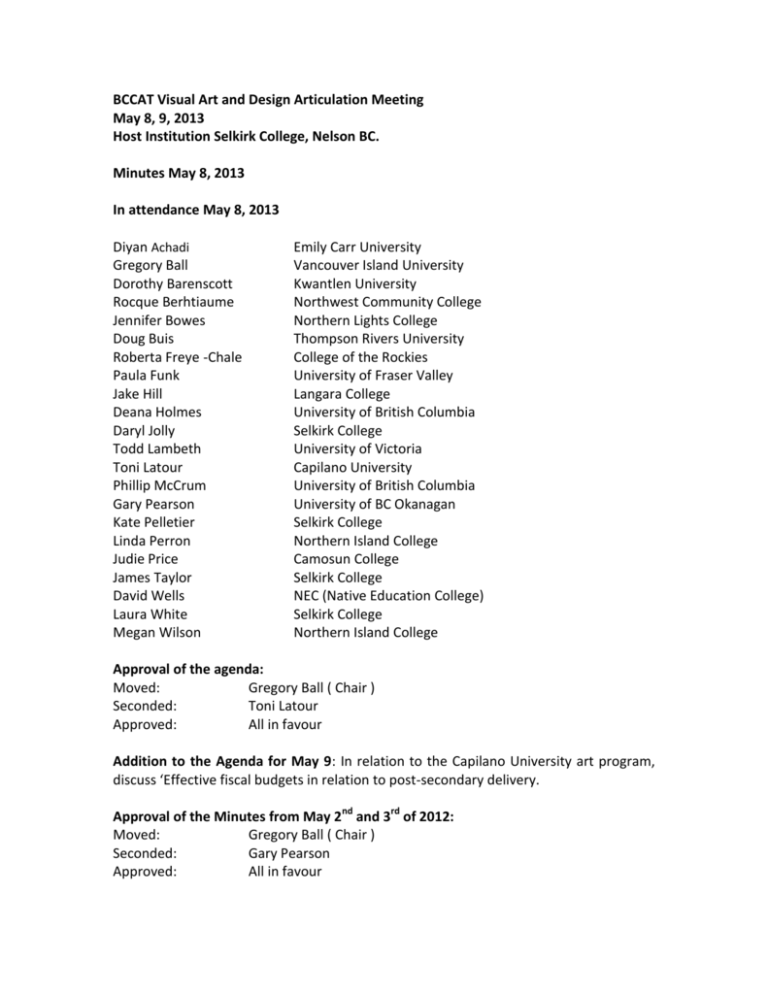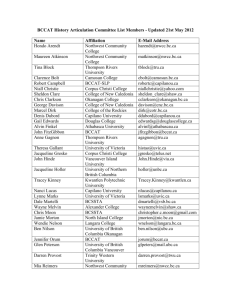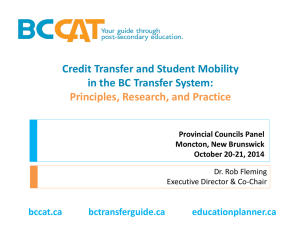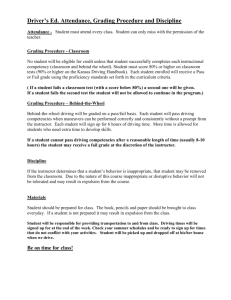Visual Arts & Design 2013 Meeting Minutes
advertisement

BCCAT Visual Art and Design Articulation Meeting May 8, 9, 2013 Host Institution Selkirk College, Nelson BC. Minutes May 8, 2013 In attendance May 8, 2013 Diyan Achadi Gregory Ball Dorothy Barenscott Rocque Berhtiaume Jennifer Bowes Doug Buis Roberta Freye -Chale Paula Funk Jake Hill Deana Holmes Daryl Jolly Todd Lambeth Toni Latour Phillip McCrum Gary Pearson Kate Pelletier Linda Perron Judie Price James Taylor David Wells Laura White Megan Wilson Emily Carr University Vancouver Island University Kwantlen University Northwest Community College Northern Lights College Thompson Rivers University College of the Rockies University of Fraser Valley Langara College University of British Columbia Selkirk College University of Victoria Capilano University University of British Columbia University of BC Okanagan Selkirk College Northern Island College Camosun College Selkirk College NEC (Native Education College) Selkirk College Northern Island College Approval of the agenda: Moved: Gregory Ball ( Chair ) Seconded: Toni Latour Approved: All in favour Addition to the Agenda for May 9: In relation to the Capilano University art program, discuss ‘Effective fiscal budgets in relation to post-secondary delivery. Approval of the Minutes from May 2nd and 3rd of 2012: Moved: Gregory Ball ( Chair ) Seconded: Gary Pearson Approved: All in favour BCCAT Visual Art and Design Articulation Meeting Page 2 May 8, 2013 Introductions and welcome by Gregory Ball Introduction of Christi Garneau: Articulation Coordinator (via Skype) BC Council of Admissions and Transfer Refer to the attached document titled ‘BCCAT Report to Articulation Committees – Spring 2013”. We had difficulty with the line during this presentation. The information is clearly stated on the document provided. GENERAL BUSINESS Action Item #1 – Gregory Ball will find a System Liason Person for future Articulation meetings Background: SLP acts as a bridge between the Articulation committee and the Ministry. The BCCAT handbook has a section explaining the role of a SLP. Flexible Pre-Majors - It was agreed that a ‘Flexible Pre-Major’ refers to the first two years, where they would choose their major in the third year of a degree granting program. Discussion ensued. Some key points include: differing student goals and plans to reach them; the push for degrees across campuses, especially to serve multiple faculties; students transferring into a different institution in 3 rd year and issues surrounding credit caps; transitioning from 2-year college courses to 4-year university courses; varied institutional curricula and course content; receipt of a general credit upon portfolio review which is beneficial to instructor and student. Ongoing communication with the Ministry is needed. Suggest BCCAT website to see where students travel throughout their studies. Discussion on how Dual Credit students fit into the system relating to transfer agreements. The ‘College Readiness’ course might be a good idea for International students as an ‘early alert’. Students can work with a counselor in adult education. The emphasis would be on getting the English skills up. Action Item #2 – Gregory Ball to Keep other representative aware of Special Topics Courses coming available. Background: Professors will let Gregory know, in advance, of what Special Topics Courses, Field Trips, and Collaborations are being planned in May/June so Gregory can forward the information to others. Student Accountability – Discussion ensued; key points included: need to support a more diverse body of learners; students don’t necessarily seek the help they need and often have a sense of entitlement, view education as a commodity and have high expectations; cultural differences that need to be taken into account; May 8, 2013 BCCAT Visual Art and Design Articulation Meeting Page 3 challenges in receiving needed support for students from varied backgrounds. We also need to look at students with Dual admission. Round Table Kwantlen Polytechnic University, represented by Dorothy Barenscott University of British Columbia – Okanagan, represented by Gary Pearson Northwest Community College, represented by Rocque Berhtiaume Camosun College, represented by Judith Price University of Victoria, represented by Todd Lambeth Langara College, represented by Jake Hill Native Education College, represented by David Wells University of British Columbia, represented by Phil McCrum and Deana Holmes Thompson Rivers University, represented by Doug Buis Northern Lights College, represented by Jennifer Bowes Vancouver Island University, represented by Gregory Ball Selkirk College (Kootenay School of Art), represented by Jason Taylor, Daryl Jolly, Kate Pelletier, Laura White (AM only) North Island College, represented by Linda Perron and Megan Wilson Capilano University, represented by Toni Latour University of the Fraser Valley, represented by Paula Funk College of the Rockies, represented by Roberta Freye-Chale Emily Carr University, represented by Diyan Achadi Attachments to Minutes Department of Creative Studies, UBC Okanagan University of Victoria, Visual Arts Vancouver Island University, Visual Arts Selkirk College (Kootenay School of the Arts) North Island College, School of Fine Art and Design Capilano University, Summary of Department University of the Fraser Valley College of the Rockies, Fine Arts Program Summary BCCAT Report to Articulation Committees – Spring 2013 BCCAT List of Pending Transfer Credit Evaluation System (TCES) Requests BCCAT Visual Art and Design Articulation Meeting Page 4 May 8, 2013 Minutes May 9, 2013 In attendance May 9, 2013 Diyan Achadi Gregory Ball Dorothy Barenscott Rocque Berhtiaume Jennifer Bowes Doug Buis Roberta Freye-Chale Paula Funk Jake Hill Deana Holmes Daryl Jolly Todd Lambeth Toni Latour Phillip McCrum Gary Pearson *Kate Pelletier Linda Perron Judie Price James Taylor David Wells Megan Wilson Emily Carr University Vancouver Island University Kwantlen University Northwest Community College Northern Lights College Thompson Rivers University College of the Rockies University of Fraser Valley Langara College University of British Columbia Selkirk College University of Victoria Capilano University University of British Columbia University of BC Okanagan Selkirk College Northern Island College Camosun College Selkirk College NEC (Native Education College) Northern Island College Tour of the Studio Spaces, Selkirk College (Kootenay School of the Arts) FINE ARTS GRADING STANDARDS DISCUSSION Grading and Attendance Policies - Vancouver Island University – Moved from a 10 pt. system to a 4.33 point system in 2010. Group reviews with other instructors and students are flagged midway giving students a clear idea about where they are before continuing to the second year. - Kwantlen University – High schools seem to be inflating grades. Kwantlen is starting to fail students when they don’t meet requirements. The Deans are really good at supporting this policy. - UBCO –The grading system is the same as Kwantlen. Illness/Health/Incidents - There are a host of arguments for absence from class. Attendance needs to be assessed case by case and handled individually. - Northwest College –There seems to be a lowering of standards in relation to writing and comprehension, citation skills, etc. There seems to be a decline in Academic literacy. We should compare the grading from one institution to another. Attendance/appeal policies need to be formalized through the Education Council or Senate (in relation to UFV’s new attendance policies). In regard to First Nations students, there needs to be an effort to make the environment more welcoming. May 8, 2013 - - - - - - - - - BCCAT Visual Art and Design Articulation Meeting Page 5 Selkirk College – Trades and Visual Arts have different grading models. There are three grading models, including University Transfer, Career based and Trades. There used to be 13 grading models. UBC – Students who are having trouble in the first year are flagged and the registrar is made aware of any problems. Incompletes are marked as an ‘R’ or ‘DNW’. This is used as a flag/tool to let other officers know that a particular student didn’t complete a portion of the course. If other programs are approached about an extension – the data can be reviewed. UBC looks at official documentation/doctor’s notes to make authoritative calls relating to attendance. Extensions can be from April to August. Instructors do need to put a grade in at the end of classes – this grade can be changed afterwards when the work is revised. The student sees the grade and this causes action, rather than a problem being ignored. One complication is that the scholarships are throughout the University. The Visual Arts programs are in competition with other Humanities/Arts and Science courses. Students do come in from other programs. Camosun – Part-time and cohort students/systems are treated different. There are midterm reviews in lieu of final interviews. At midterm, students are made aware if they are in trouble. Aside from these interviews, students are notified about their success level in the course. There is a need to maintain consistency throughout the faculty. There is a percentage allocated to attendance and participation. The grading matrix is similar to the University of Victoria. Capilano University - Adoption of a new grading profile based on the UBC model. Attendance – Flexibility can be to the benefit of the student, when the door is open to have a dialogue about it. Max – 10% for participation and attendance (as part of their overall grade). Low grades can snowball a student and have an effect on their future. Incompletes (I) are useful; however, they can be a problem for sessional instructors. University of Victoria – 9pt. grading system – percentage system. A+ = 90-100%. This can be problematic. The classes can be top-heavy. There is a need to be very specific on how students are evaluated. Objectives need to be clearly stated ahead of time. University of Fraser Valley - The department is putting in place attendace policies — Attendance is mandatory; extensions require a medical note; early departures and lateness are noted; two un-negotiated absences could result in failure; five absences, regardless of the reason results in removal from the program. There is a revised policy for the appeal process — Students have to go to the ‘Student Affairs Office’. Appeals need to be put in writing within 30 days. Extensions — a limit of 6 weeks or according to a contract. It is the student’s responsibility to follow-up. Emily Carr University – 5% deductions for absence; 2% for early departure. If a student is 1hr late for a 6hr class, this is considered an absence. This is across the board for foundation courses and Fine Arts. College of the Rockies - The grade is broken down in terms of composition, colour mixing, creativity, etc. Grade appeals relating to students - sometimes the students are there for the grade and don’t know that much about art. It is important to break down the grades for each project and parts of each project. Langara – A+ = 95% or higher. There are complications between Painting, Sculpture and Design. Enter letter grades into the system – otherwise students negotiate their percentages relating to the letter grades. Within Design – they use GPA. The design assignments are more ‘markable’, as well as sculpture in terms of rubrics. Printmaking sticks to the percentages. It is difficult to grade creativity – especially for students who work the rubric; students can fulfill all of the requirements without creativity. Marks May 8, 2013 - - - - BCCAT Visual Art and Design Articulation Meeting Page 6 meeting at the end of the semester. The letter ‘N’ is assigned when the course is incomplete, rather than giving a letter grade. Students can submit later. It is the responsibility of the faculty to grade the student work at a later date. Native Education College - Transfer status – looking school wide to check out problems in terms of compatibility between courses and skill level (academic). The system is quasi-public. There is a lack of flexibility. Quality assurance – commodity based model. 20% dismissal policy for attendance. Students need to put through assessments fairly early on before the refund dates. Quality assurance framework, between the students and the industry standards. Thompson Rivers University – There haven’t been any changes to the grading matrix. The Deans have expressed the need to follow the grading curve. What happens if you have a really good class? We need to work with each student and have them produce good work. Is it the narrative that is more important with the students, more than the grading? The letter grade doesn’t really indicate the level students are at. A ‘B’ can look different from one student to another. The problem can be that students work towards the grade, negotiating the amount of credits, etc. The grades do count for scholarships, but it is usually the portfolio that really counts for entry. We need to focus on students building a strong portfolio. Northern Lights College – A+ = 95% or higher. The dual credit students have a zerotolerance attendance policy enforced by the School district. Student contracts with the corresponding high schools. Instructors have to submit monthly reports on attendance for these students. Three unexcused absences result in a letter grade reduction. Lateness and early departures are noted. These terms are stated in each course outline. North Island College - A+ = 95% or higher. Class critiques and reports given to the students as well as having in-class discussions. Attendance is assessed case by case. For students applying for transfer credit – there are inconsistencies between institutions in relation to integrity of work. We need to clearly set what the expectations are and perhaps standardize grades between institutions. THEMATIC DISCUSSION, The Effects of Fiscal Budgets and Their Relationships to Program Delivery Capilano University – During the installation of the Studio Art Grad show (during exam week) the studio art coordinator was called into a meeting and told that the program was proposed to be cut. This was a shock, as the degree proposal process was underway. The proposal was to combine textiles and studio art to make a unique degree – Bachelor of Material Art practices. Since the proposed cuts, - There is huge support for the programs by the faculty, students, artists in the community, NDP politicians, CARFAC, the BC Craft Association, there are online petitions, letters written by many individuals, protest banners, art draped in black on campus, radio, TV, print and online press. There is a small window of opportunity to prevent the closure of the program. - The final stop is at the Board of Governors on May 14th. - Capilano University is serving a different community than Emily Carr University. It also has unique facilities including a bronze foundry and a digital jacquard loom Diversity in art education is essential. BCCAT Visual Art and Design Articulation Meeting Page 7 May 8, 2013 ----------Motion put forward – Toni Latour Seconded by – Rocque (Northwest Community College) Motion passed – everyone in Favour “We the Articulation committee for BC Visual Arts programming recognize the unique qualities of the studio art and textiles programs at Capilano University and support their important place in the diversity in Art Education and the creative economy in British Columbia. We recommend to the board that they reject any program and section cuts, to continue to engage government in discussion of proper funding and to engage the University community in a fulsome discussion about its strategic directions and evolving an academic plan.” ----------General Discussion on Fiscal cuts to programming - Selkirk College - in approximately 2006, Selkirk assisted the Kootenay School of Arts. There was a decline in enrollment. They are now moving more towards a craft program, rather than focusing on academic elements. The college has looked at other ways of saving money. There has been a 30% drop in travel budgets across the board. Cutting down on paper and travel between campuses. There are other ways to make cuts rather than making drastic decisions, such as cutting programs. The faculty should be able to have a creative vote in the changes. - North West Community College - The system has become more hierarchical and grown into a more private sector model – loaded on the side of administration and lack of marketing. - College of the Rockies - The students need to be engaged with the discussion. We need to help change the perception around the arts – behind every art work is a person. - Camosun - There is a push to start eight month programs that are cost recovery. - UBCO - There is a push towards media arts and a growing divide between Art and its history. An industry-driven set of skills is more remote from the history of Art and Design. This is creating duality within the student body. There is a push to offering more courses with reductions in the operation budget. The material fees go up every year by 2%. On average, students pay between $50-100 per courses. UBC - $35/class. May 8, 2013 BCCAT Visual Art and Design Articulation Meeting Page 8 PLANNING FOR 2014 BCCAT ARTICULATION MEETING Dates for the next Articulation meeting: May 7th and 8th (W/R) Host Institution: Emily Carr University Thematic Discussion Topic: Creative Economy – What Is The Role Of Arts In The Community? Other Topics of Note: Class Sizes : Building Solidarity Space/Allocation/Management Pedagogy






